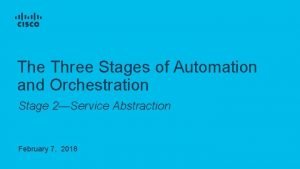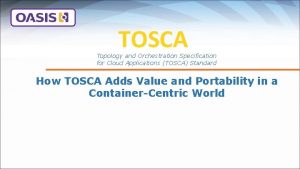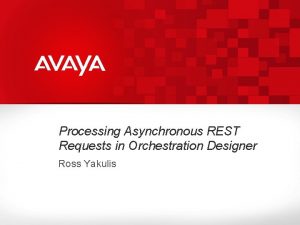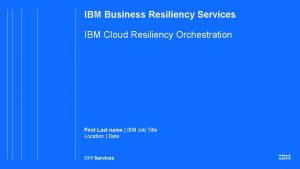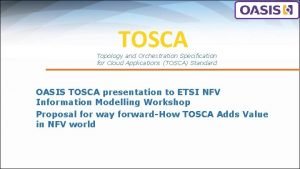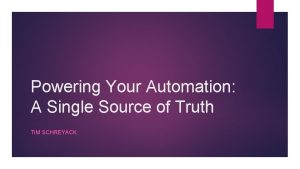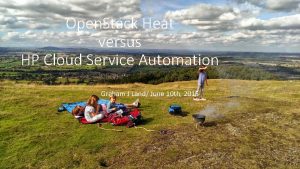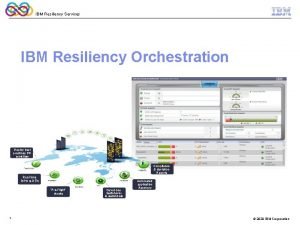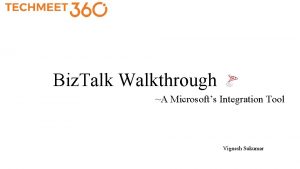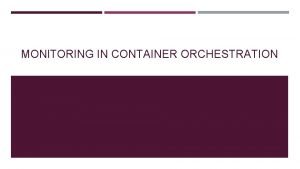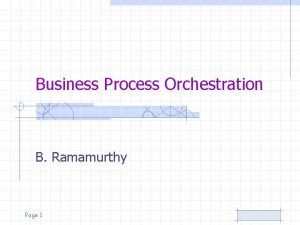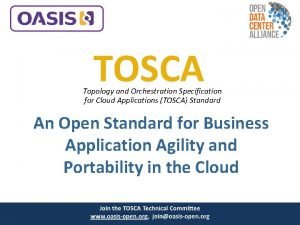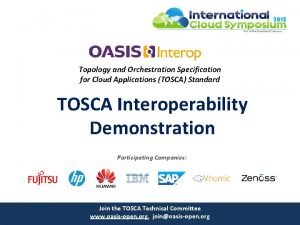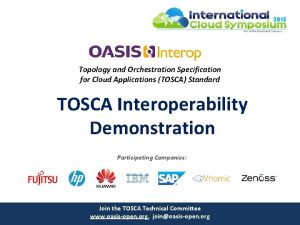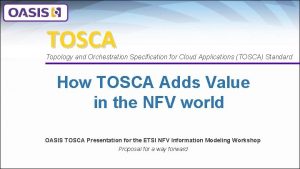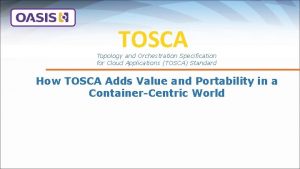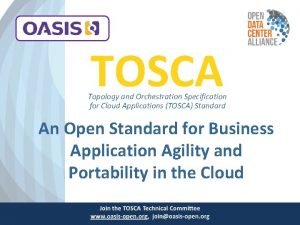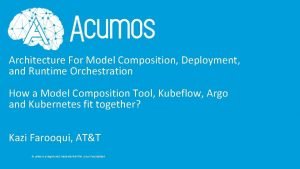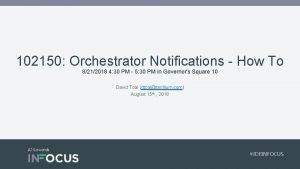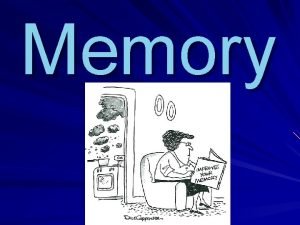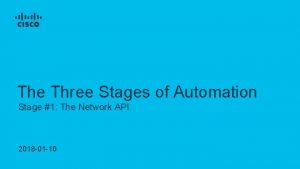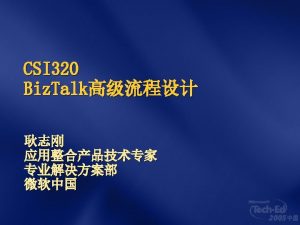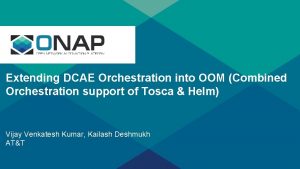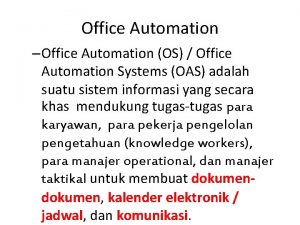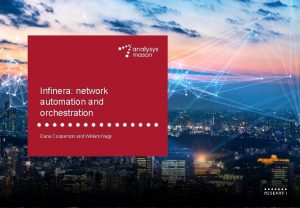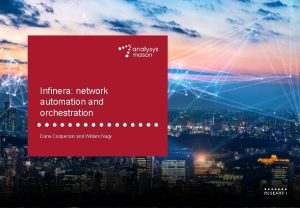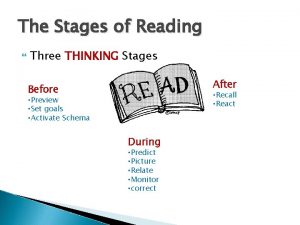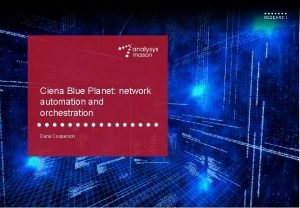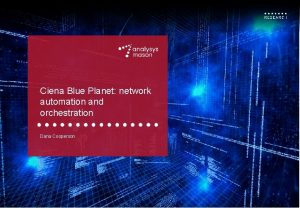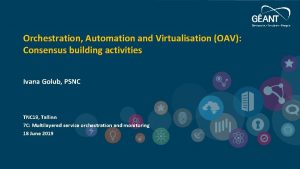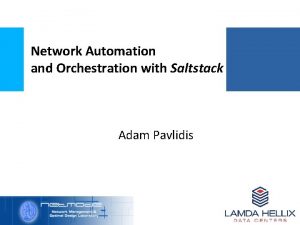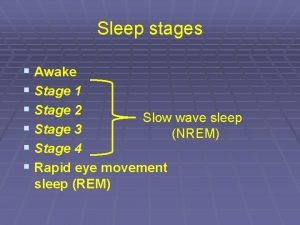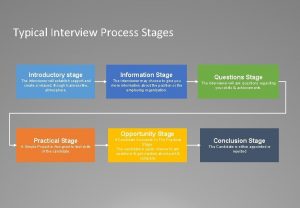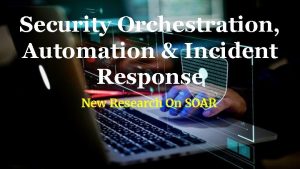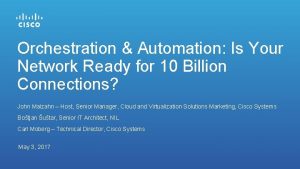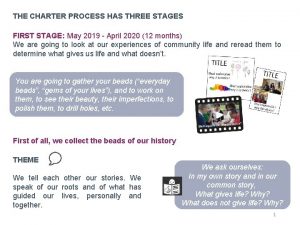The Three Stages of Automation and Orchestration Stage










































- Slides: 42

The Three Stages of Automation and Orchestration Stage 2—Service Abstraction February 7, 2018

Today’s Presenters John Malzahn Carl Moberg Senior Manager, Cloud and Virtualization Solutions Marketing Technology Director, Cloud Solutions and Platform Group Cisco Systems © 2018 Cisco and/or its affiliates. All rights reserved.

Today’s Agenda © 2017 2018 Cisco and/or its affiliates. All rights reserved. 1 Introducing the Three Stages of Automation 2 Deep Dive on Stage #2 Service Abstraction 3 Using NSO for Service Abstraction 4 Demo Time! 5 Wrap-up and Q&A

Key Market Trend Observations Execution at the speed of software • Networks provides well-known utility abstractions • Agility, Dev. Ops, NFV, SDN drives new expectations Changing customer behavior and new expectations • Everything on demand • New services with a press of a button Rapidly changing business models • Cloud services, virtualization, programmable networks • New value chains including OTT Co-opetition All of this requires successful, flexible automation. But complexity has destroyed many automation initiatives. © 2018 Cisco and/or its affiliates. All rights reserved.

Departmental Pain Points Network Engineer “Automation” Ops and Provisioning Team “Customer Experience” Service Developers “Time-to-Market” Day-to-day management of rapidly growing, complex networks Provisions services and manages service quality in networks Develops new network services on demand Challenges • Error-prone manual tasks • Growing backlog • Virtualization is coming Challenges • No service insight • Lack of automation • Quality issues in delivery Challenges • Implementation time • Cost of change • Lack of tooling © 2018 Cisco and/or its affiliates. All rights reserved.

Transition Towards Automation Network Engineer “Automation” Ops and Provisioning Team “Customer Experience” Service Developers “Time-to-Market” Day-to-day management of rapidly growing, complex networks Provisions services and manages service quality in networks Develops new network services on demand Challenges • Error-prone manual tasks • Growing backlog • Virtualization is coming Challenges • No service insight • Lack of automation • Quality issues in delivery Challenges • Implementation time • Cost of change • Lack of tooling Network API Utilize a single interface to all network devices Service Abstraction Leverage one central API for all services Transformation Develop your own services © 2018 Cisco and/or its affiliates. All rights reserved.

Change Requirements Current Situation Target Model People Walled-off departments, lacking software skills Cross-functional teams with software skills Process Waterfall operations for network operation and services Dev. Ops approach across tools development and operations Technology Rigid, built for single purpose, proprietary Network abstractions built for Dev. Ops with modern technologies © 2018 Cisco and/or its affiliates. All rights reserved.

Devops Virtual Cycle Market Requirements Service Requests Operational Requirements Development Testing DEV Production OPS r to i on M Network Operations © 2018 Cisco and/or its affiliates. All rights reserved.

Devops Virtual Cycle (Todays Focus) Market Requirements Service Requests Operational Requirements Development Testing DEV Production OPS r to i on M Network Operations © 2018 Cisco and/or its affiliates. All rights reserved.

Poll Question #1 Have you, or are you planning to provide an API for services to your network © 2018 Cisco and/or its affiliates. All rights reserved.

Transition Towards Automation Network Engineer “Automation” Ops and Provisioning Team “Customer Experience” Service Developers “Time-to-Market” Day-to-day management of rapidly growing, complex networks Provisions services and manages service quality in networks Develops new network services on demand Challenges • Error-prone manual tasks • Growing backlog • Virtualization is coming Challenges • Lack of automation • Quality issues in delivery • No service insight Challenges • Implementation time • Cost of change • Lack of tooling Network API Utilize a single interface to all network devices Service Abstraction Leverage one central API for all services Transformation Develop your own services © 2018 Cisco and/or its affiliates. All rights reserved.

Challenge Mapping Lack of automation • • Mix of scripted and manual steps Outdated or proprietary tools and processes © 2018 Cisco and/or its affiliates. All rights reserved. High cost of maintenance for services

Challenge Mapping Lack of automation • • Mix of scripted and manual steps Outdated or proprietary tools and processes High cost of maintenance across service lifecycle Quality issues in delivery • • Fallout recovery using manual steps Lacking support for in-flight service changes © 2018 Cisco and/or its affiliates. All rights reserved. Negative impact on customer experience

Challenge Mapping Lack of automation • • Mix of scripted and manual steps Outdated or proprietary tools and processes High cost of maintenance across service lifecycle Quality issues in delivery • • Fallout recovery using manual steps Lacking support for in-flight service changes Negative impact on customer experience No Service insight • • Services are ships in the night with the network No understanding of servicelevel fault-mapping © 2018 Cisco and/or its affiliates. All rights reserved. Long and error-prone recovery times

Quick System Overview Network Engineering Ops and Provisioning Service Developers NSO Service Manager CDB Device Manager ESC (VNFM) Device Abstraction NED Package Manager NED VNF Lifecycle Manager Multi-domain Networks © 2018 Cisco and/or its affiliates. All rights reserved. VNF Service Monitoring • Model-driven end-to-end service lifecycle and customer experience in focus • Seamless integration with existing and future OSS/BSS environment • Loosely-coupled and modular architecture leveraging open APIs and standard protocols • Orchestration across multi-domain and multi-layer for centralized policy and services across entire network

Feature Mapping #1 Service Models and APIs © 2018 Cisco and/or its affiliates. All rights reserved.

The Challenge • We need: A formal and well understood means of understanding and working with the service layer… • allowing for use of modern, mainstream tools and practices • • On: Brownfield networks • Across place in network, vendor, device type and protocol • Expose the services layer using formal language and approaches that match the technology choices of modern development teams © 2018 Cisco and/or its affiliates. All rights reserved.

Model-driven Means Choice! Protocols and languagebindings are used to lifecycle the service instances The service models define the valid content of service instances in CDB © 2018 Cisco and/or its affiliates. All rights reserved.

Pick the Tools that Work for You with m. start_read_trans() as t: rt = ncs. maagic. get_root(t) for svc in rt. ncs__services. service: netconf-console --get-config -x '/services' GET /api/config/services HTTP/1. 1 CDB © 2018 Cisco and/or its affiliates. All rights reserved.

Create • Easy • Given a set of service- level inputs, provide a known and valid output to network • May require some additional resource collection to fulfill the configuration set Update Delete • Challenging • Hard • Allow arbitrary changes • Delete any given to the network service • May require collecting or handing back resources to fulfill configuration set instance of a service and clean up the resources • May require reference counting for shared resources The ability to dry-run all operations is key for trust © 2018 Cisco and/or its affiliates. All rights reserved.

Feature Mapping #2 Fail-safety with Transactions © 2018 Cisco and/or its affiliates. All rights reserved.

The Challenge • We need: A comfortable programming environment on the northbound interface. . . • implementing well known data manipulation abstractions (create, read, update, delete) • • On: Brownfield networks • Across place in network, vendor, device type and protocol • Make the network look like a single database with all service instances represented in a single, easy-to manage data tree © 2018 Cisco and/or its affiliates. All rights reserved.

Fully Synchronous 1. Client performs operation on service instance 2. Orchestrator resolves dependencies, resource situation, creates per-device intent 3. Orchestrator performs intentdriving operations to affected resources 4. Orchestrator returns result © 2018 Cisco and/or its affiliates. All rights reserved.

Fully Synchronous 1. Client performs operation on service instance 2. Orchestrator resolves Lock dependencies, resource situation, creates per-device intent 3. Orchestrator performs intentdriving operations to affected resources 4. Orchestrator returns result © 2018 Cisco and/or its affiliates. All rights reserved.

Eventually Consistent (Commit Queues) 1. Client performs operation on service instance 2. Orchestrator confirms the reception of the operation 3. Orchestrator: • Creates per-resource intent • Puts queue items in per-resource queues © 2018 Cisco and/or its affiliates. All rights reserved. 4. Orchestrator works through queues and updates queue item sattus 5. Client polls or gets notified on queue item completion

Eventually Consistent (Commit Queues) 1. Client performs operation on service instance 2. Orchestrator confirms the reception of the operation 3. Orchestrator: Lock • Creates per-resource intent • Puts queue items in per-resource queues © 2018 Cisco and/or its affiliates. All rights reserved. 4. Orchestrator works through queues and updates queue item sattus 5. Client polls or gets notified on queue item completion

Two Modes for Network Programmability Fully Synchronous • Big Pro • • • Very comfortable for the developer, no fallout coding Somewhat Con • Eventually Consistent Leverages global locks, may lead to contenting Big Pro • • Parallel execution, minimal to no lock contention Somewhat Con • Potentially tricky fallout situations and client state management Need to consider usage patterns, service types, frequency of change, size of network, characteristics of clients, etc. © 2018 Cisco and/or its affiliates. All rights reserved.

Feature Mapping #3 Service Insight © 2018 Cisco and/or its affiliates. All rights reserved.

The Challenge • We need: A way to understand the relationship between the service lifecycle and the resources in the network (configuration, runtime state)… • Using easily accessible constructs (references) both up- and down the stack • • On: Brownfield networks • Across place in network, vendor, device type and protocol • Provide referential integrity across services and resources in a fashion that allows actionable operations (planning, what-if, fallout, capacity management) © 2018 Cisco and/or its affiliates. All rights reserved.

Three Common Service Operations Issues • Recovering from out-of-band changes • Relocating services in an upgrade/migration scenario • Create resource views for service-oriented fault management © 2018 Cisco and/or its affiliates. All rights reserved.

Recover From Out-of-band Changes • • © 2018 Cisco and/or its affiliates. All rights reserved. Referential integrity is broken between service layer and device layer Redeploy service instance to reproduce resource intent Produce diff between intent and actual Remediate using diff

Relocate Service for Upgrade or Migration • • • Service resources needs to be moved across devices Redeploy the service with the new device input Resulting diff will include: Configuration to be removed from evacuated device • Configuration to be added to arriving device • © 2018 Cisco and/or its affiliates. All rights reserved.

Resource Views for Fault Management • • • © 2018 Cisco and/or its affiliates. All rights reserved. Device is out of order and not able to support service Service operations team queries service instances for references to lost device Remediation activities may including moving service, or replacing device

Poll Question #2 How do you currently or plan to handle your API development? © 2018 Cisco and/or its affiliates. All rights reserved.

Demo Time © 2018 Cisco and/or its affiliates. All rights reserved.

Operators Voted Cisco Leads Industry In Lifecycle Service Orchestration LSO and OSS Leaders OSS Vendors Deployed Today Cisco 52% Ciena (Blue Planet) Cisco 30% Ericsson Amdocs 28% NEC/Netcracker 24% Other Nokia 24% Ericsson Amdocs 20% Accenture 16% IBM 16% Oracle 16% HPE UBIqube Other 2% Comptel 2% 0% 22% 20% HPE 18% Nokia 18% 14% 8% Oracle 8% Accenture 10% IBM 10% 4% ADVA (Ensemble) 24% NEC/Netcracker 14% CENX 38% 12% Comptel 10% 20% 30% 40% 50% 60% 4% 0% 10% 20% 30% 40% Source: SDx. Central 2017 Next-Gen OSS and the Rise of LSO Report © 2018 Cisco and/or its affiliates. All rights reserved. PSOSPG-2940 36

What You Gain with Cisco Network Services Orchestrator, Enabled by Tail-f • Agility throughout service lifecycle Strict YANG model-driven solution - Auto-rendered business logic results in 90% less code - Effortlessly re-deployment of updated service and device models - Dev. Ops for differentiation - • Full automation • Robust and proven in tier-1 deployments • Industry’s broadest multivendor support • Relevant in today’s and tomorrow’s networks © 2018 Cisco and/or its affiliates. All rights reserved.

Next Webinar in the Three Stages Series Network Engineer “Automation” Ops and Provisioning Team “Customer Experience” Service Developers “Time-to-Market” Day-to-day management of rapidly growing, complex networks Provisions services and manages service quality in networks Develops new network services on demand Challenges • Error-prone manual tasks • Growing backlog • Virtualization is coming Challenges • No service insight • Lack of automation • Quality issues in delivery Challenges • Implementation time • Cost of change • Lack of tooling January 10 © 2018 Cisco and/or its affiliates. All rights reserved. February 7 March 7

NSO Dev. Net – Key Highlights The one place to use for sharing, finding and collaborating on NSO public knowledge! Light start through Dev. Net content page and Learning. Labs Constant news and updates to help you keep up to date Large searchable content pool Cisco customers, partners and employees all have access Got a question, ask! We will help ensure a fast response developer. cisco. com/site/nso © 2018 Cisco and/or its affiliates. All rights reserved. Easy to share and find public content Code sharing through public Git. Hub

For More Information Visit: www. cisco. com/go/nso and contact your Cisco account representatives Visit Us at Mobile World Congress — Feb 26–Mar 1 Cisco Booth Hall 3, Space 3 E 30 © 2018 Cisco and/or its affiliates. All rights reserved.

Questions? © 2018 Cisco and/or its affiliates. All rights reserved.

 Stages of automation
Stages of automation Single stage tendering advantages and disadvantages
Single stage tendering advantages and disadvantages Stage right stage left diagram
Stage right stage left diagram Database applications
Database applications Orchestration designer
Orchestration designer Multi domain service orchestration
Multi domain service orchestration Ibm resilient map customer journey
Ibm resilient map customer journey Broadband services bbs
Broadband services bbs Tosca topology
Tosca topology Orchestration is about codifying tasks
Orchestration is about codifying tasks Hp cloud orchestration
Hp cloud orchestration Ibm resiliency orchestrator
Ibm resiliency orchestrator What is real time interaction management
What is real time interaction management Biztalk esb tutorial
Biztalk esb tutorial Conversation orchestration
Conversation orchestration Container orchestration monitoring
Container orchestration monitoring Business process orchestration
Business process orchestration Tosca demo
Tosca demo Tosca cloud orchestration
Tosca cloud orchestration Tosca orchestration
Tosca orchestration Cisco data center orchestration
Cisco data center orchestration Firmware orchestration
Firmware orchestration Tosca orchestration
Tosca orchestration Tosca cloud orchestration
Tosca cloud orchestration Tosca orchestration
Tosca orchestration Kubeflow architecture diagram
Kubeflow architecture diagram Jde watchlist
Jde watchlist Step one denial step two
Step one denial step two Upstage right
Upstage right Proscenium stage diorama
Proscenium stage diorama Stage right stage left
Stage right stage left Atkinson and shiffrin's three-stage model of memory
Atkinson and shiffrin's three-stage model of memory Organizing items into familiar manageable units
Organizing items into familiar manageable units Ap psychology chapter 9 memory
Ap psychology chapter 9 memory Maylor four stage model
Maylor four stage model Hình ảnh bộ gõ cơ thể búng tay
Hình ảnh bộ gõ cơ thể búng tay Ng-html
Ng-html Bổ thể
Bổ thể Tỉ lệ cơ thể trẻ em
Tỉ lệ cơ thể trẻ em Voi kéo gỗ như thế nào
Voi kéo gỗ như thế nào Tư thế worm breton là gì
Tư thế worm breton là gì Hát lên người ơi
Hát lên người ơi Các môn thể thao bắt đầu bằng tiếng đua
Các môn thể thao bắt đầu bằng tiếng đua
